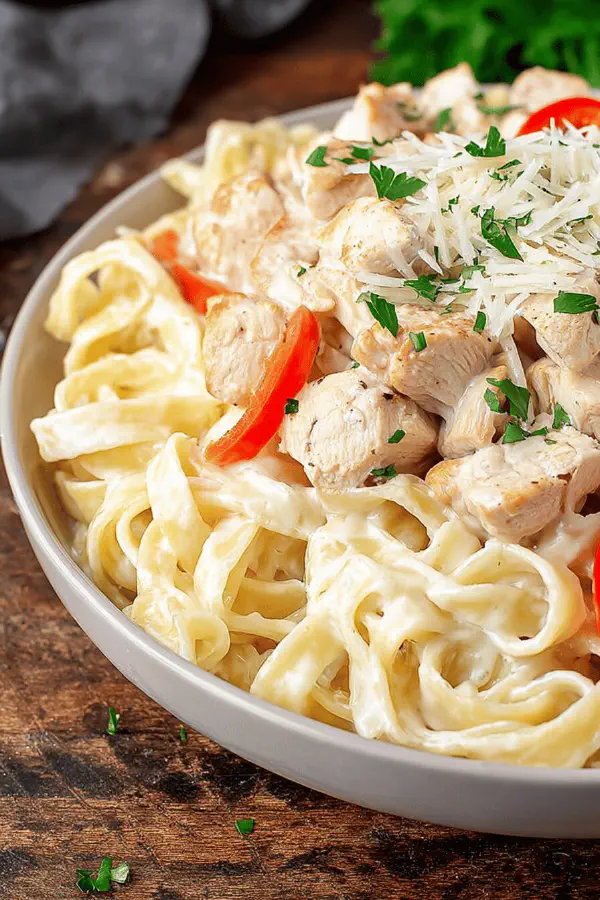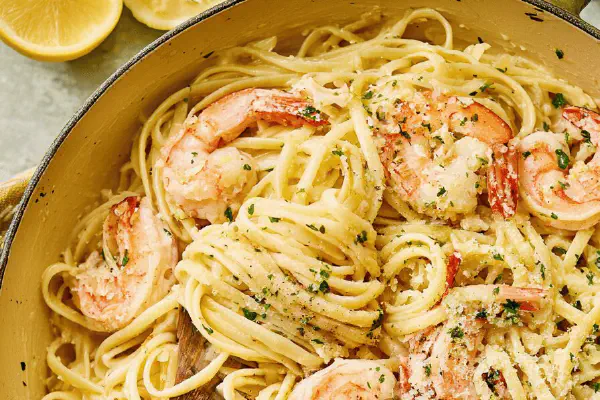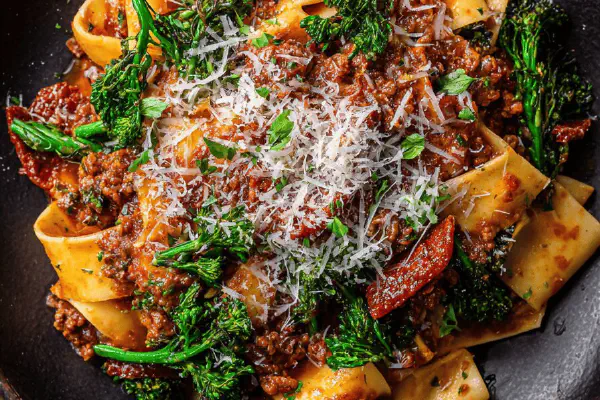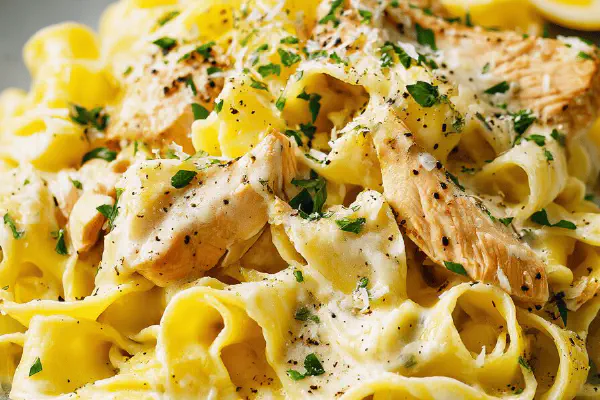Featured Recipe
Chicken Fettuccine Alfredo Twist

By Kate
"
Creamy pasta with seared chicken, sautéed vegetables, and a rich cheese sauce. Heavy cream and butter form the base with parmesan melted in for depth. Onion and bell peppers add sweetness and texture. Garlic lends aroma but watch the heat to avoid bitterness. The fettuccine cooks separately to al dente before combining. Olive oil sears seasoned chicken until just opaque, then veggies soften in the same pan preserving flavor. Sauce thickens by gentle simmer, careful to whisk and prevent burning. Serve by tossing everything together. Swap chicken for turkey breast, red pepper for poblano, parmesan for asiago for a sharper edge. Timing keyed on visual cues, not clock.
"
Prep:
12 min
Cook:
28 min
Total:
40 min
Serves:
6 servings
pasta
comfort food
weeknight dinner
italian cuisine
Introduction
Alfredo is about patience and timing. Cream and cheese meld only if heat’s controlled, no scorched bits. Chicken—turkey here—gets that edge where outside crisps slightly while inside stays tender. Onion and poblano bring color and subtle spice, no flat flavor allowed. Garlic must only soften; blackened garlic is a quick way to ruin this. Pasta cooks elsewhere, so no sticky mess. Managing all three elements prevents sloppy or bland muck. Remember; heat management is the silent key. Chop smart—thin slices for even cooking, not chunks. A sprinkle of asiago instead of parmesan pushes this over the line into complexity. Keep sauce loose, not gluey. Fresh parsley brightens the entire plate before you even taste it. You’re in control of every sizzling, bubbling moment.
Ingredients
About the ingredients
Fettuccine is your starch base, but wide noodles like pappardelle or tagliatelle can work if you want more sauce retention. Turkey breast is a leaner spin on chicken; both handle seasoning the same. Poblano peppers add a mild smoky heat alternative to sweet red peppers; swap back if you don’t want any kick. Asiago cheese contributes sharper tang and melts well but can be replaced with aged gouda or a blend of parmesan and pecorino for different profiles. Heavy cream and butter ratio is crucial to avoid greasy or watery sauce—always start with cold cream and melt butter slowly to keep emulsification stable.
Method
Prepare Pasta and Chicken
- Boil salted water vigorously. Drop fettuccine and cook until just shy of al dente; pasta firms with slight chew. Drain well and set aside in colander to avoid mush.
- Pat turkey dry. Season with salt and pepper generously; dry surface stays tender and browns better.
- Heat 2 tablespoons olive oil in large skillet over medium-high flame. Lay turkey strips single layer in hot oil; don’t crowd or stir often. Listen for steady sizzle. Flip when one side turns opaque but still moist inside, about 4-5 minutes total. Remove with slotted spoon, drain fat if sticky or smokey. Cover and keep warm.
- Reduce heat to medium. Add remaining olive oil if pan looks dry. Toss in onion and poblano; stir slow. Onion softens, turning translucent. Poblano wilts but retains slight crunch; about 6 minutes.
- Add minced garlic; toss quickly and stir for 1 to 1 1/2 minutes as aroma blooms. Garlic burns fast so stay close—brown edges equal bitter taste. Mix turkey back in.
- Cover pan loosely. Let turkey finish cooking through by steaming with veggies for 4-5 minutes. Check with slice; no pink.
- Meanwhile, in a separate saucepan, combine heavy cream and butter over medium heat. Watch butter melt into cream, no rush.
- Once combined, sprinkle in asiago cheese gradually, whisk vigorously to incorporate smoothly. Cheese adds salt and texture; mix till sauce thickens and is velvety—should coat spoon, not run off immediately.
- Avoid boiling hard; keep at gentle simmer. Stir frequently. Adjust salt and pepper. Sauce too thick? Add splash of cream or milk.
- Return drained pasta to big bowl. Add turkey and veggie mix. Ladle sauce over promptly to avoid pasta drying out.
- Toss carefully but fully; pasta should look glossy and coated, with meat and peppers evenly distributed.
- Garnish with fresh parsley for a pop of color and slight herbal note.
- Serve immediately. If sauce thickens too much while resting, stir in splash of warm cream or broth.
Vegetables and Aromatics
Alfredo Sauce
Assembly
Technique Tips
Start pasta in salted boiling water—use large pot for freedom to stop sticking. Timing pasta slightly before you need it means you avoid overcooking when assembling last steps. Dry turkey well before season and sear to get crisp edges; wet chicken steams and resists browning. Use a slotted spoon to remove protein to keep oil from burning; if pan gets sticky or smokes, wipe it out or add fresh fat like olive oil. Sweating onion and poblano means cooking slowly until onion is translucent; this unlocks sweetness without caramelization. Garlic needs brief introduction in pan after veggies soften; watch for aroma and pale gold, no brown. Covering pan finishes cooking meat with gentle steam, less tough than flipping nonstop.
Chef's Notes
- 💡 Pasta must be timed right. Boil well. Al dente, firm texture. Drain; avoid mush. Toss with sauce immediately. Keep the fettuccine glossy. Sometimes re-season after cooking.
- 💡 Pat dry your turkey. Good surface for browning. Salt fresh; pepper enhances. Single layer in the pan helps crisp edges. Don't overcrowd. Flip when opaque, juicy inside.
- 💡 Vegetables need slow cooking. Reduce heat for onions, softer sweet. Poblano for mild spice. Toss garlic in after veggies. Don’t let garlic burn. Watch closely, quick timing counts.
- 💡 Sauce needs patience. Control temperature. Cream and butter should meld—no boiling. Whisk in asiago gradually. Sauce must coat spoon without running off. Adjust thickness mid-cooking.
- 💡 Assembly must be timed. Reintroduce turkey, then combine with pasta gently. Toss together with sauce quickly. Herbs boost colors and freshness. Skip heavy piling.
Kitchen Wisdom
How to avoid sticky pasta
Stir in boiling water. Use lots. Salt well. Drain before mush forms. Toss with sauce right after draining.
Sauce too thick?
Add a splash of cream or broth. Adjust consistency for better cling. Don't panic; just whisk and simmer again.
Ware to store leftovers?
Airtight container in fridge. Reheat gently, splash cream. Microwave works, but use low heat. Avoid overcooking again.
Can I freeze it?
Yes but sauce may separate slightly. Freeze in portions. Thaw overnight when ready. Reheat carefully to maintain texture.



